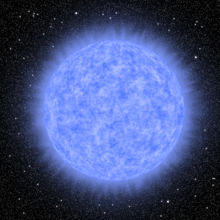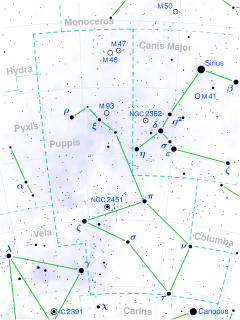Zeta Puppis
| Observation data Epoch J2000 Equinox J2000 | |
|---|---|
| Constellation | Puppis |
| Right ascension | 08h 03m 35.1s[1] |
| Declination | −40° 00′ 11.6″[1] |
| Apparent magnitude (V) | 2.24 - 2.26[2] |
| Characteristics | |
| Spectral type | O4If(n)p[3] |
| U−B color index | −1.09[4] |
| B−V color index | −0.27[4] |
| Variable type | rotating?[2]
|
| Absolute magnitude (MV) | −6.23[5] |
| Details | |
Myr | |
| 198752. | |
| Database references | |
| SIMBAD | data |
Zeta Puppis (ζ Puppis, abbreviated Zeta Pup, ζ Pup), formally named Naos /naʊs/,[12] is the brightest star in the constellation of Puppis.
The
Zeta Puppis is typical of O-type stars in having an extremely strong stellar wind, measured at 2,500 km/s,[13] which sees the star shed more than a millionth of its mass each year,[13] or about 10 million times that shed by the Sun over a comparable time period.
Nomenclature
ζ Puppis (Latinised to Zeta Puppis) is the star's Bayer designation.
It bears the name Naos, from the Greek ναύς "ship", and in Arabic Suhail Hadar (سهيل هدار). In 2016, the International Astronomical Union organized a Working Group on Star Names (WGSN)[14] to catalogue and standardize proper names for stars. The WGSN approved the name Naos for this star on 21 August 2016 and it is now so entered in the IAU Catalog of Star Names.[12]
Namesake
Physical characteristics

Zeta Puppis has been extensively studied because of the rarity of such hot massive stars and its relative closeness to Earth, but its physical parameters and distance are still poorly known. It would be a valuable step on the cosmic distance ladder, clarifying the distance of other high luminosity stars in the Milky Way galaxy and external galaxies.
The spectral type is O4If(n)p. O4 indicates a hot massive hydrogen-burning star, typically 40,000–44,000K.
Variability

The brightness of Zeta Puppis varies slightly but regularly. Its apparent magnitude varies between a peak of 2.24 and a minimum of 2.26 over 1.78 days.
It also shows variations in
Distance
The distance of Zeta Puppis is disputed, most commonly being considered to be 332±11 pc based on its Hipparcos parallax, or 460±40 pc based on its expected physical properties. Its association with objects such as the
The physical properties of the star depend strongly on its distance, with its
The angular size of Zeta Puppis has been measured interferometrically to be 0.41 mas,[21] and photometrically to be 0.38 mas.[22]
Helium
In 1896, Williamina Fleming observed mysterious spectral lines from Zeta Puppis, which fit the Rydberg formula if half-integers were used instead of whole integers. It was later found that these were due to ionized helium.[23]
Origin
Early suggestions for the birthplace of Zeta Puppis were the very young Vela R2 stellar association at around 800pc and the Vela OB2 association at 450pc.[24] Neither origin is satisfactory. A distance of 800pc requires an abnormally high luminosity, while the Vela OB2 association is much older than Zeta Puppis and the space velocity does not lead back to that cluster.
Many physical models and the original Hipparcos parallax measurements did lead to a distance value of around 450pc, but the revised Hipparcos reduction gave a much lower distance near 333pc. A recent dynamical study points to Zeta Puppis originating in the Trumpler 10 OB association at around 300pc, but this is also a much older cluster and physical models still lead to a distance of 450-600pc.[6]
Zeta Puppis shows a high space velocity and very high rotation rate, and it has been speculated that it is a runaway star resulting from a supernova in a binary system, possibly the progenitor of the Gum Nebula.[25] Models of binary systems are able to reproduce the properties of Zeta Puppis following mass transfer from a companion which then exploded as a supernova. This can explain the observed properties which are inconsistent with single star evolution.[20][16]
References
- ^ S2CID 18759600.
- ^ AAVSO. Retrieved 2022-06-15.
- S2CID 119248206.
- ^ Bibcode:2002yCat.2237....0D.
- ^ S2CID 119280104.
- ^ S2CID 18791701.
- .
- ^ S2CID 55083993.
- ^ Bibcode:2012ASPC..465..342V.
- S2CID 226955884.
- Bibcode:1991bsc..book.....H.
- ^ a b "IAU Catalog of Star Names". Retrieved 28 July 2016.
- ^ doi:10.1086/305218.
- ^ "IAU Working Group on Star Names (WGSN)". International Astronomical Union. Retrieved 22 May 2016.
- S2CID 119297513.
- ^ .
- Bibcode:2009yCat....102025S.
- Bibcode:1996A&A...306..899B.
- S2CID 118470320.
- ^ .
- .
- Bibcode:1983A&A...118..245K.
- S2CID 11988018.
- Bibcode:1996A&A...305..825V.
- .

